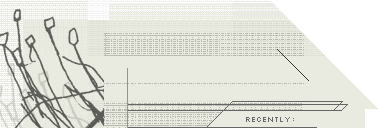The music emanating from this Norwegian trio is a strange
seducer. Well-spaced keyboard tones ebb into the undulating cosmic backdrop
of warm melodic synths and wheezing horns, but despite the clarity of
this lush, harmonious atmosphere, Come Up for Air are strangely evasive,
and always seem to be retreating into the distance.
Coupled with the inviting, downright pretty arrangements, this mysterious
element allows the group to pique listeners' interest while also keeping them
at a distance. As a result, even after numerous songs unfold, certain aspects
of the sound remain undecided, an absence of completion that lets
Ola Fløttum, Hans Christian, and Ulf Rogde take slight
detours, an opportunity they put to good use on several occasions. Sometimes
the ramshackle drum patterns, previously prominent, drop out entirely, while
other times the resonating peal of withdrawn guitar melodies gives onto downbeat
rhythms that propel the track headfirst into a web
of star-crossed analog synths and soaring keyboard figures.
"Stand Over Me" possesses a relaxed fluidity. The piece begins simply, with a
sparse keyboard motif pattering alongside gently pulsating layers of noise. Fløttum's
steamy baritone voice emerges patiently, weaving itself into the song's many
threads, which dangle breezily for minutes on end. Although he's joined now and
again by Susanna Wallumrod (from Susanna and the Magical Orchestra), Fløttum's
voice is often placed high in the mix. Being as affecting and flexible as it
is — he
effortlessly shifts from reflective murmurs to an angelic falsetto on many an
occasion — his voice might nevertheless have been used more sparingly so
as to let the other instruments assume more well-rounded characters.
Elsewhere, songs similarly find a fragile stasis, bringing to mind images of
people standing still in a snowy silence. Much of the work is indeed mellow and
ponderous, yet it is also peppered with enough urgency and upbeat momentum to
keep the album from becoming altogether detached. "We Are Not
the Ones" merges both of these styles, with vaporous trails of
ambience buoyed by bubbling, oscillating electronic pads that are as playful
as they are serene.
During these moments, the production of Helge Sten (of Deathprod and Supersilent fame) seems noticeable, as his hand ensures
that there is no individuality in these songs. Instead, each alteration sends
so many reverberations surging back into the heart of the track that each of the layers reflects and accentuates this recent movement.
Without further ado, the album ends on a song that has nothing final about it; it reads like just another track, one that should give onto something else. Were it otherwise, though, this album, essentially a pop album with a rather weak pulse, would very likely suffocate under a welter of well-worn signs. It is interesting to note, then, that this disappearing act is what allows the band to carry this traditional form into more fertile ground.
|

